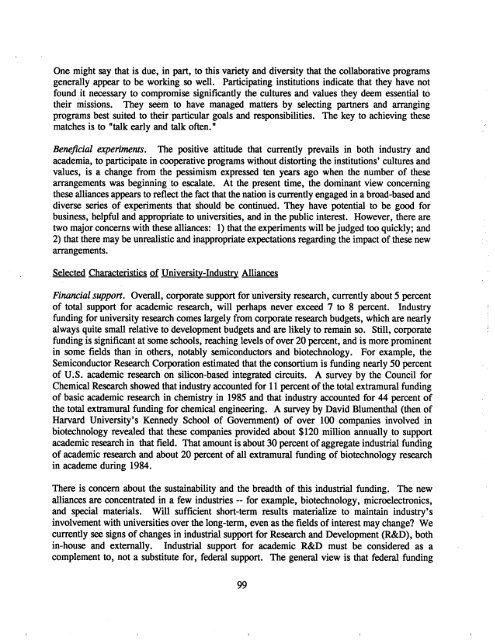WHOI-90-52
WHOI-90-52
WHOI-90-52
You also want an ePaper? Increase the reach of your titles
YUMPU automatically turns print PDFs into web optimized ePapers that Google loves.
One might say that is due, in par, to this varety and diversity that the collaborative programs<br />
generally appe to be working so well. Parcipating institutions indicate that they have not<br />
found. it necssa to compromise significatly the cultures and values they deem essential to<br />
their missions. They sem to have managed matters by selecting parers and aranging<br />
programs best suite to their parcular goals and responsibilties. The key to achieving these<br />
matches is to "tak ealy and tak often."<br />
Beneficial experiments. The positive attitude that currently prevails in both industr and<br />
academia, to parcipate in coperative programs without distortng the institutions' cultures and<br />
values, is a change from the pessimism expresse ten yeas ago when the number of these<br />
arangements was beginning to escate. At the present time, the dominant view concerning<br />
these alliances appes to reflect the fact that the nation is currently engaged in a broad-base and<br />
diverse series of experiments that should be continued. They have potential to be goo for<br />
business, helpful and appropriate to universities, and in the public interest. However, there are<br />
two major concerns with these alliances: a that the experiments wil be judged too quickly; and<br />
2) that there may be unreaistic and inappropriate expetations regarding the impact of these new<br />
arangements.<br />
Selected Charcteristics of University-Industr Allances<br />
Financial support. Overa, corprate support for university resech, currently about 5 percent<br />
of tota support for academic resech, wil perhaps never exce 7 to 8 percent. Industr<br />
funding for university resech comes largely from corprate resech budgets, which are nealy<br />
always quite small relative to development budgets and are likely to remain so. Stil, corprate<br />
funding is significat at some schools, reaching levels of over 20 percent, and is more prominent<br />
in some fields than in others, notably semiconductors and biotechnology. For example, the<br />
Semiconductor Resech Corpration estimate that the consortum is funding nealy 50 percent<br />
of U.S. academic resech on silcon-base integrate circuits. A survey by the Council for<br />
Chemica Resech showed that industr accounte for 11 percent of the tota extramural funding<br />
of basic academic resech in chemistr in 1985 and that industr accounted for 44 percent of<br />
the tota extrmura funding for chemica engineering. A survey by David Blumenthal (then of<br />
Harard University's Kennedy School of Government) of over 100 companies involved in<br />
biotehnology reveaed that these companies provided about $120 milion annually to support<br />
academic resech in that field. That amount is about 30 percent of aggregate industral funding<br />
of academic resech and about 20 percent of all extrmura funding of biotechnology resech<br />
in academe during 1984.<br />
There is concern about the sustanabilty and the breadth of this industrial funding. The new<br />
alliances are concentrate in a few industres -- for example, biotechnology, microelectronics,<br />
and speial materials. Wil sufficient short-term results materialize to maintan industr's<br />
involvement with universities over the long-term, even as the fields of interest may change? We<br />
currently se signs of changes in industral support for Resech and Development (R&D), both<br />
in-house and externally; Industral support for academic R&D must be considered as a<br />
complement to, not a substitute for, federa support. The genera view is that federal funding<br />
99
















